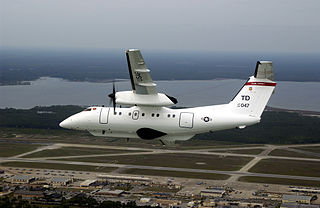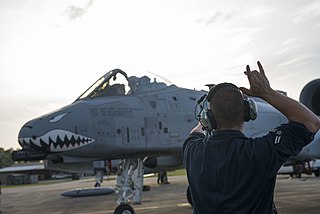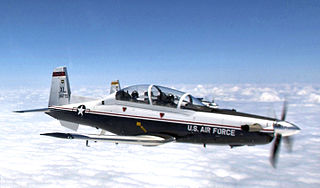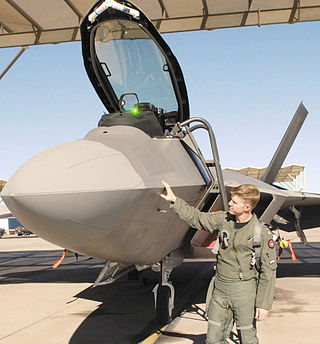
Hamilton Field was a United States Air Force base, which was inactivated in 1973, decommissioned in 1974, and put into a caretaker status with the Air Force Reserve until 1976. It was transferred to the United States Army in 1983 and was designated an Army Airfield until its BRAC closure in 1988. It is located along the western shore of San Pablo Bay in the southern portion of Novato, in Marin County, California.

The 82nd Aerial Targets Squadron is a United States Air Force unit. It is assigned to the 53rd Weapons Evaluation Group and stationed at Tyndall Air Force Base, Florida.

The 78th Air Base Wing is a wing of the United States Air Force stationed at Robins Air Force Base, Georgia. The 78th acts as the host unit at Robins.

The 62d Fighter Squadron is part of the United States Air Force 56th Operations Group at Luke Air Force Base, Arizona. It operates the Lockheed Martin F-35A Lightning II aircraft conducting advanced fighter training.

The 75th Fighter Squadron(75 FS) is a United States Air Force unit. It is assigned to the 23d Fighter Group, Air Combat Command and stationed at Moody Air Force Base, Georgia. The squadron is equipped with the Fairchild Republic A-10C Thunderbolt II attack aircraft.

The 78th Fighter Group is an inactive United States Air Force unit. It was last assigned to the 78th Fighter Wing, at Hamilton Air Force Base, California. It was inactivated on 1 February 1961.

The 84th Flying Training Squadron was part of the United States Air Force 47th Flying Training Wing based at Laughlin Air Force Base, Texas. It operated Beechcraft T-6 Texan II aircraft conducting flight training.

The 498th Fighter-Interceptor Squadron is an inactive United States Air Force unit. Its last assignment was with Air Defense Command stationed at Hamilton Air Force Base, California. It was inactivated on 30 September 1968.

The 59th Test and Evaluation Squadron is a United States Air Force unit. It is assigned to the Air Combat Command 53d Wing, 53d Test Management Group at Nellis Air Force Base, Nevada.

The 15th Test and Evaluation Squadron is a United States Air Force unit, stationed at Eglin Air Force Base, Florida and assigned to the 753rd Test and Evaluation Group. It was first activated in the expansion of the United States military forces prior to World War II as the 15th Pursuit Squadron. It moved to Panama in 1942, where it participated in the defense of the Panama Canal. It returned to the United States, where it was a Replacement Training Unit for fighter pilots until 1944, when it was disbanded as the 15th Fighter Squadron in a reorganization of Army Air Forces training units in 1944

The 98th Fighter-Interceptor Squadron is an inactive United States Air Force unit. Its last assignment was with the New York Air Defense Sector of Air Defense Command stationed at Suffolk County Air Force Base, New York, where it was inactivated on 30 September 1968.

The 29th Test and Evaluation Squadron is an active United States Air Force unit. It is assigned to the 753d Test and Evaluation Group, at Eglin Air Force Base, Florida.

The 53rd Test and Evaluation Group is a group of the United States Air Force. It is a part of the 53rd Wing, and is headquartered at Nellis AFB, Nevada.

The 4707th Air Defense Wing is a discontinued United States Air Force organization. Its last assignment was with the 26th Air Division of Air Defense Command (ADC) at Otis Air Force Base, Massachusetts where it was discontinued in 1956.

The 4709th Air Defense Wing is a discontinued United States Air Force organization. Its last assignment was with the 26th Air Division of Air Defense Command (ADC) at McGuire Air Force Base, New Jersey, where it was discontinued in 1956. It was established in 1952 at McGuire as the 4709th Defense Wing in a general reorganization of Air Defense Command (ADC), which replaced wings responsible for a base with wings responsible for a geographical area. It assumed control of several fighter Interceptor squadrons that had been assigned to the 52d Fighter-Interceptor Wing, some of which were Air National Guard squadrons mobilized for the Korean War. It also assumed host responsibility for McGuire through its subordinate 568th Air Base Group.

The San Francisco Air Defense Sector (SFADS) is an inactive United States Air Force organization. Its last assignment was with the 28th Air Division, being stationed at Beale Air Force Base, California.
The 4706th Air Defense Wing is a discontinued United States Air Force (USAF) organization. Its last assignment was with the 37th Air Division of Air Defense Command (ADC) at O'Hare International Airport (IAP), Illinois where it was discontinued in 1956. It was established in 1952 at O'Hare as the 4706th Defense Wing in a general reorganization of Air Defense Command (ADC), which replaced wings responsible for a base with wings responsible for a geographical area. It assumed control of several Fighter Interceptor squadrons that had been assigned to the 142d Fighter-Interceptor Wing, an Air National Guard wing mobilized for the Korean War and the 56th Fighter-Interceptor Group. In early 1953 it also was assigned six radar squadrons in the Midwest and its dispersed fighter squadrons combined with colocated air base squadrons into air defense groups. The wing was redesignated as an air defense wing in 1954. It was discontinued in 1956 and most of its units transferred to the 58th Air Division.

The 575th Air Defense Group is a disbanded United States Air Force organization. Its last assignment was with the 4708th Air Defense Wing at Selfridge Air Force Base, Michigan, where it was inactivated in August 1955. The group was originally activated as the 575th Air Service Group, a support unit for the 4th Fighter Group after the 4th returned to the United States at the end of World War II and performed that mission until it was inactivated in 1947.

The 564th Air Defense Group is a disbanded United States Air Force organization. Its last assignment was with the 4707th Air Defense Wing, at Otis Air Force Base, Massachusetts, where it was inactivated in 1955. The group was originally activated as the 564th Air Service Group, a support unit for a combat group at the end of World War II but never deployed before it was inactivated in 1945.

The 566th Air Defense Group is a disbanded unit of the United States Air Force. Its last assignment was with the 28th Air Division at Hamilton Air Force Base, California, where it was inactivated on 18 August 1955. The group was originally activated as the 566th Air Service Group, a support unit for a combat group at the end of World War II but never deployed before it was inactivated in 1945.

























